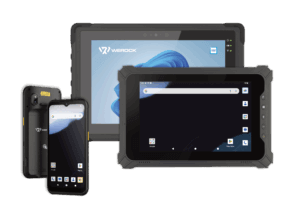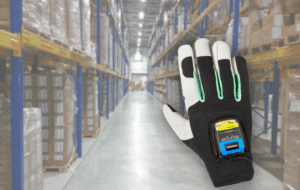Digitization, a burning issue throughout the modern working world, is also playing an increasingly important role in the skilled trades sector. The skilled trades, the backbone of the German SME sector, are a significant economic sector with over one million businesses and 5.3 million employees. Digitization measures not only make the day-to-day work of craftsmen much easier, they can also help them keep pace with the times.
A look at the current reality, however, brings something disappointing: On construction sites, for example, you still see craftsmen and architects working with conventional tools: Work pad, piece of paper, pencil and so on. Although most of them see digitization as an opportunity, as a study by Bitkom and the ZDH found out, by no means all skilled crafts businesses are digitally on the move. In the office, around two-thirds use digital applications for organizational and administrative work, although only around 20 percent use them for personnel planning.
If we take a closer look at current day-to-day work, we can see that there are even more opportunities for optimization: While many companies already rely on cloud computing and smart software to process their orders, artificial intelligence and automation by robots are less of an issue due to the high acquisition costs and IT and data security.
The great benefit of mobile digitization
Digitization strategies are expected to play a significant role in increasing efficiency and productivity in the skilled trades and construction industries, precisely because these sectors are very busy due to their good order books and the simultaneous shortage of personnel. Good news: digital technology can help employees right on the spot by equipping them with good mobile devices or specialized apps. It is these powerful tools that bridge differences between present and future, between traditional and digital. Despite the aforementioned phenomenon that craftsmen in Germany are still far from being properly digital, there is already a pleasing trend: business models are becoming increasingly digitalized, and you can already see how mobile devices are supporting employees in this respect.
In most cases, employees already have their smartphones with them, with apps such as Google Maps, Here Wego or Waze for navigating to the job site and for documentation. Increasingly, tablets and notebooks are also finding their way onto the construction site, as they are a helpful digital support in many trades. Especially when the smartphone display is too small for certain tasks, tablets make a big appearance.
In operational use, projects with different trades in particular benefit from a common exchange platform that can standardize and thus accelerate communication among numerous cooperation partners. This can save a lot of time and money on documentation, measurements and mobile document management. One example is the cooperation between floor layers and carpenters: If the floor layer stores the height of the floor coverings used in a software program, the dimensions for doors can change – and a good software program can automatically warn the customer.
Ultimately, customer satisfaction is increased by the improved user experience: For them, presentations and product videos on tablets appear much more impressive. A well-organized digital office is particularly profitable when there are numerous appointments.
Selecting the right equipment
Thanks to powerful processors and sophisticated touchscreens, current high-performance tablet PCs and notebooks offer convenient operation of trade-specific software. When buying a new tablet, however, craftsmen should pay attention to a few technical key points so that mobile work does not turn into torture: A powerful processor with at least 4 cores, 64 GB of built-in memory and three GB of RAM are essential. It is also important that not all tablets have a SIM card slot. A compact tablet is often sufficient; only if a lot of keystrokes or a particularly large display is required can a laptop be a good choice.
Regardless of whether the craftsman chooses a tablet or a laptop, he has the choice between a normal “consumer” device and an “outdoor” or “rugged” device. While it is a question of price and taste as to which of the two the user prefers, the latter should carefully examine whether the mobile device is sufficient for the environmental conditions at his work sites. On the construction site, for example, the air has a high dust concentration and rain cannot be avoided, so conventional devices quickly reach their limits here; malfunctions or a complete failure would only be a matter of time. In this case, robust end devices are highly recommended; but which brands should be considered?
While brands like Apple, Samsung and Huawei are widely used for conventional tablets, rugged products are not found at all among these brands. Brands specifically for rugged devices, which are unfortunately too often underestimated, should be the focus when choosing a customizable computer for craftsmen. WEROCK is an innovative manufacturer of rugged laptops, tablets and mobile computers. It also offers an extensive range of accessories such as shoulder straps, hand straps, vehicle charging stations, etc., which are designed for professional use. The company offers a diverse portfolio of feature-rich products for heroes in various industries: Emergency & Rescue Services, Utilities, Transportation & Logistics, Industrial Manufacturing, Public Services, Construction, etc. WEROCK devices are extremely resilient: not only can they withstand dust and water, but they can also easily withstand shocks and falls from heights sometimes exceeding one meter. Particularly resistant products are also tested according to the US military standard MIL-STD-810G/H.
However, so much safety and comfort comes at a price: depending on the size, protection class and brand, craftsmen have to budget between 500 and 3,000 euros for a purchase. The federal and state governments support craftsmen’s businesses with numerous subsidy measures, which are summarized at www.foerderdatenbank.de. One focus here is on helping craftsmen to improve their safety. One focus here is on relieving craftsmen of the cost-intensive planning of their digitization strategy.
Future outlook with digital technology
Although it will still be a few years before “Handwerk 4.0” can be widely realized in Germany, the digital trend is almost unstoppable. Machines and tools are already becoming smarter today: they are increasingly controlled by Bluetooth, making their operation much easier; they are often equipped with GPS trackers to make it more difficult to steal expensive equipment. The future of these tools looks even more digital: For example, a drying machine can use a smartphone to tell the customer that the water tank needs to be emptied; in carpentry, the sander can use sensors to alert the customer to excessive contact pressure and temperatures on the sanding pad. It would also be possible to integrate digital voice assistants in the workshop in conjunction with RFID chips: so in the future it could be “Alexa, where’s the hammer?”.
But there are also ongoing innovations in the area of terminal devices that can make life easier in the skilled trades: For example, Apple has presented various models with LiDAR scanners, which can be used to quickly capture three-dimensional objects. There is also a lot going on with devices for professional use: The hardware is becoming increasingly compact without sacrificing robustness. For example, our 10″ Rocktab U210 tablet is only 15 mm deep.
Conclusion
Whether on a smartphone, tablet or notebook – digital mobile solutions in the form of apps or web applications have a clear advantage. They are user-friendly and their logic is easy to understand. With the help of these solutions, manual work processes become much more efficient: digital checklists, handovers, and construction and damage documentation can be uploaded directly to the cloud and transmitted to the client or the office. Relief also comes in the form of invoicing, as working hours and breaks can already be recorded digitally. Furthermore, proper and legally secure working practices can be demonstrated through the purposeful use of the appropriate tools. They herald the end of the paper economy on construction sites and in handicraft businesses in general. In order to be more future-proof, robust mobile devices are indispensable. We look forward to your inquiry.











